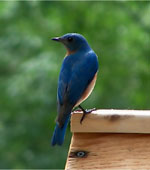– By Bet Zimmerman
Until fairly recently, bluebirds were uncommon in Connecticut. From 1900-1970, bluebird populations decreased by an estimated 90%, mainly due to loss of habitat (open space and snags), pesticide use, and competition for nesting sites from non-native starlings and house (English) sparrows. However, bluebirds are coming back. They are fascinating, beautiful birds.
There’s not much the average person can do to directly aid Bald Eagles or Whooping Cranes, but you CAN help bluebirds survive and thrive. Here’s how.
Learn to Recognize Nests and Eggs. Bluebirds build neat, cup shaped, woven nests of fine grass or pine needles, and occasionally a few feathers. Eggs are powder blue, or sometimes white. House sparrow nests are a tall jumble of odds and ends, including coarse grass, cloth and trash, feathers, twigs. Eggs are cream with irregular brown speckles. See  http://www.sialis.org/nests.htm for information on other common nestbox inhabitants, such as the iridescent, brave, mosquito-munching tree swallow.
http://www.sialis.org/nests.htm for information on other common nestbox inhabitants, such as the iridescent, brave, mosquito-munching tree swallow.
Put up Nesting Boxes. In Connecticut , bluebirds start checking out nesting sites in February to mid-March, and usually lay their first eggs in April. Build or purchase a nesting box designed specifically for bluebirds. These boxes are made of unpainted 3/4″ – 1″ wood; have an overhanging slanted roof, no perch, a round 1.5″ diameter hole (or an oval 1.375″ hole), ventilation, drainage holes; are deep enough so predators can’t reach in and get to the eggs; and have a door that opens for cleaning and monitoring. Mount boxes on 8 ft., 3/4″ diameter galvanized pipe, with the entrance hole 5 ft. off the ground. The best locations are semi-open grasslands, such as mowed meadows, large lawns, cemeteries, orchards, roadsides, and areas with scattered trees and short ground cover.
Note: Bob Smith, who passed away last year, built thousands of bluebird homes that the ECFLA sold at fairs and events ECFLA is looking for one or two volunteers to help assemble bluebird houses that ECFLA/WDLT sells as fundraisers at local fairs in August and September. ECFLA/WDLT supplies the fixtures and boards, but needs some people who have good woodworking/construction skills to help. Please contact ECFLA if you are interested.
Control Predators and House Sparrows. Install predator guards to keep raccoons etc. from raiding nests (e.g., a 2 ft. long, 8″ diameter stovepipe or PVC pipe sleeve on the pole, mounted under the box). DON’T hesitate to destroy house sparrow nests and eggs. House sparrows, which some bluebirders refer to as “rats with wings,” are introduced invasive pests, and are not protected by law. You might think they’re cute, but they will attack and kill adult bluebirds (sometimes trapping them in the nest box), and destroy eggs and young. House sparrow nests, eggs, young, and adults may be legally removed or destroyed. It is better to have no box at all than to allow house sparrows to reproduce in one.
Supplement Food and Water. Bluebirds don’t eat bird seed. Plant native trees, shrubs or vines that provide fall and winter food for bluebirds, such as flowering dogwood, holly, mulberry, wild grape, and Virginia creeper. Consider offering mealworms. Birdbaths should be no more than 3″ deep, with gently sloping sides, and a rough surface. Remember to change the water every few days to keep it fresh.
Don’t get discouraged if you don’t get bluebirds nesting the first year – it’s worth the wait! For more information, see http://www.sialis.org/http://www.sialis.org/http://www.sialis.org/

